The Intel Core i9-7980XE and Core i9-7960X CPU Review Part 1: Workstation
by Ian Cutress on September 25, 2017 3:01 AM ESTBenchmarking Performance: CPU Rendering Tests
Rendering tests are a long-time favorite of reviewers and benchmarkers, as the code used by rendering packages is usually highly optimized to squeeze every little bit of performance out. Sometimes rendering programs end up being heavily memory dependent as well - when you have that many threads flying about with a ton of data, having low latency memory can be key to everything. Here we take a few of the usual rendering packages under Windows 10, as well as a few new interesting benchmarks.
All of our benchmark results can also be found in our benchmark engine, Bench.
Corona 1.3: link
Corona is a standalone package designed to assist software like 3ds Max and Maya with photorealism via ray tracing. It's simple - shoot rays, get pixels. OK, it's more complicated than that, but the benchmark renders a fixed scene six times and offers results in terms of time and rays per second. The official benchmark tables list user submitted results in terms of time, however I feel rays per second is a better metric (in general, scores where higher is better seem to be easier to explain anyway). Corona likes to pile on the threads, so the results end up being very staggered based on thread count.
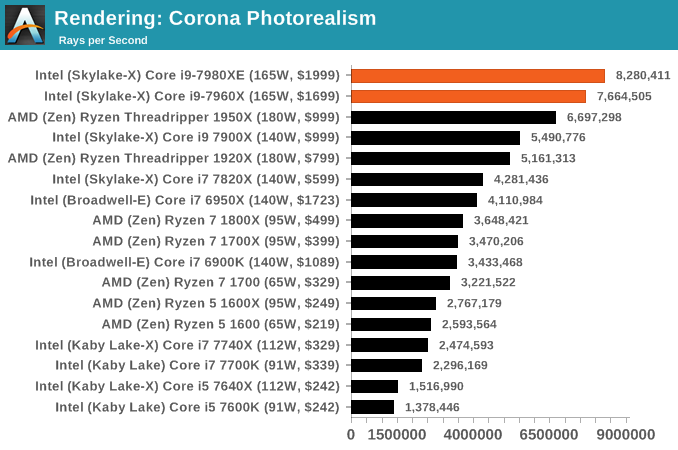
Blender 2.78: link
For a render that has been around for what seems like ages, Blender is still a highly popular tool. We managed to wrap up a standard workload into the February 5 nightly build of Blender and measure the time it takes to render the first frame of the scene. Being one of the bigger open source tools out there, it means both AMD and Intel work actively to help improve the codebase, for better or for worse on their own/each other's microarchitecture.

LuxMark v3.1: Link
As a synthetic, LuxMark might come across as somewhat arbitrary as a renderer, given that it's mainly used to test GPUs, but it does offer both an OpenCL and a standard C++ mode. In this instance, aside from seeing the comparison in each coding mode for cores and IPC, we also get to see the difference in performance moving from a C++ based code-stack to an OpenCL one with a CPU as the main host.
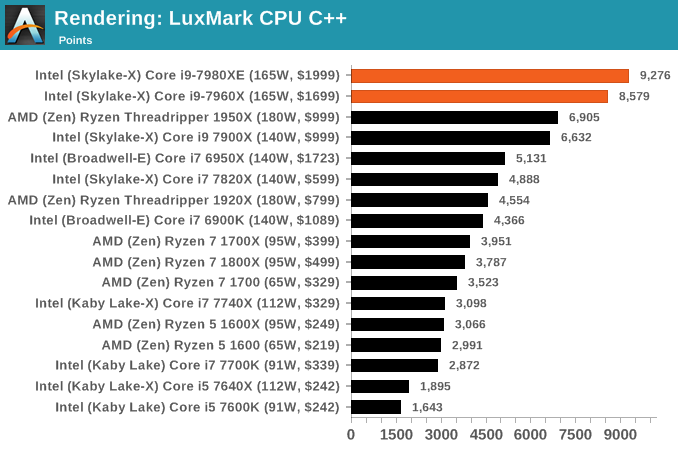
POV-Ray 3.7.1b4: link
Another regular benchmark in most suites, POV-Ray is another ray-tracer but has been around for many years. It just so happens that during the run up to AMD's Ryzen launch, the code base started to get active again with developers making changes to the code and pushing out updates. Our version and benchmarking started just before that was happening, but given time we will see where the POV-Ray code ends up and adjust in due course.
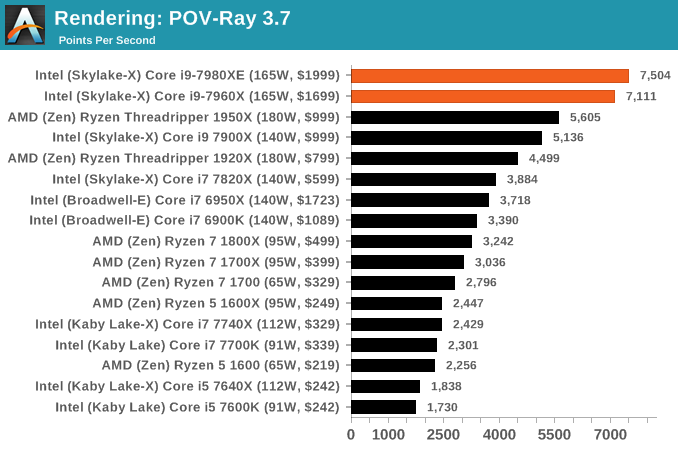
Cinebench R15: link
The latest version of CineBench has also become one of those 'used everywhere' benchmarks, particularly as an indicator of single thread performance. High IPC and high frequency gives performance in ST, whereas having good scaling and many cores is where the MT test wins out.
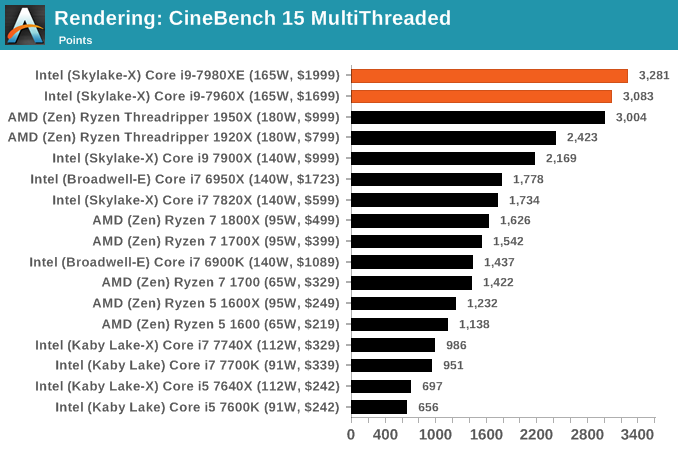
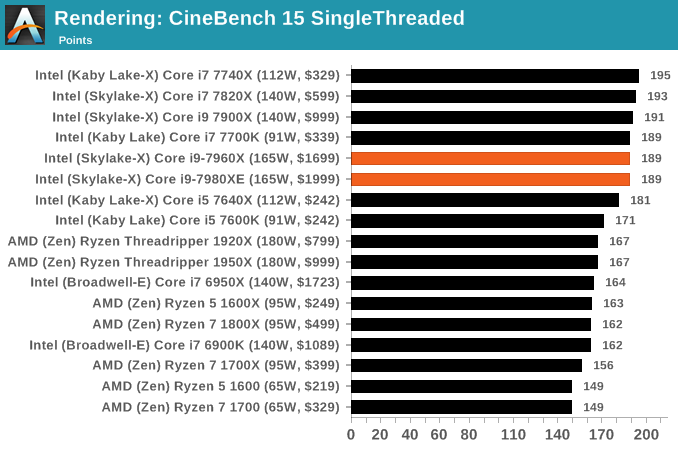










152 Comments
View All Comments
Spunjji - Monday, September 25, 2017 - link
Super relevant, because they indicate how badly thermally limited the CPU is - which is hella good info to have if you're, say, considering delidding a $1999 processor because the manufacturer used toothpaste under the IHS.tricomp - Monday, September 25, 2017 - link
Poor AMD...No chance they are going to supply (even more) cpu's demand after posting this article..
I am trying to purchase at list 7 systems for my customers in my country but there's nowhere I can find them beasts here..
iwod - Monday, September 25, 2017 - link
I wish someone could do an article on that too. GF doesn't seems to be the limitation here. GF, should in theory more then enough capacity in their Fab 8 for AMD. Unless GF have some other big customers, otherwise AMD should really be bumping out as much unit as possible.Atom11 - Monday, September 25, 2017 - link
Can we please see one test (!), if you could possible manage, that shows the advantage of AVX-512 in compare to AVX2 when doing:1.) matrix multiply
2.) FFT
3.) convolution
ZeDestructor - Monday, September 25, 2017 - link
Give us a comparison to AVX1 and SSE4 too!Gothmoth - Monday, September 25, 2017 - link
threadripper delivers 80+% of the perfromance for less than 50% of the price.... you don´t have to be a genius to see what the better deal is (price germany: TR 1950x = 950 euro, 7890xe =2300 euro)Spunjji - Monday, September 25, 2017 - link
Don't let that stop them equivocating about how companies who need that power yet somehow have no need for ECC don't care about cost because something something software TCO blah blah.spdragoo - Monday, September 25, 2017 - link
I'm trying really, really hard to think of a company that, at some point or another, doesn't say, "Equipment X may outperform Equipment Y, but the extra cost to buy Equipment X is too much, we'll just make-do with Y instead." Especially since 100% of companies have a limit on their budgets.What's that, you say? Multi-billion dollar corporations don't have to worry about the money they spend? Someone apparently didn't pay attention in their Econ 200 class, or their Introduction to Accounting coursework.
By definition, every business has a *finite* amount of money they can spend, based on a) how much money they collect from their customers, b) how much they can recoup on the sale of assets (tangible or intangible), & c) how much they can get from "other sources" (mostly bank loans or by selling stock shares, or sometimes government grants, but you might find the occasional situation where a generous benefactor just bequeaths money to a company...but I doubt you'll even see that happen to 1% of the companies out there -- & no, venture capitalists pouring money into a company is *not* a situation where they "give the money away", they're getting something for their money, usually stock shares or guarantees of repayment of the loans). Of that money, some of it is earmarked for employee compensation (not just the executives, but the office drones & lower-level employees that do 99% of the actual work), some of it goes towards taxes, some of it pays for rental payments, some for loan payments, some for utilities (telephone, Internet, electricity, gas, water, etc.), some of it may get set aside for "emergencies", some gets earmarked for dividends to the shareholders, etc. That means that a (relatively) small portion is set aside for "equipment replacement". Now, if the company is lucky, the lion's share of that budget is for IT-related equipment...but that covers more than just the office drones' machines, that covers everything: server racks, storage services, cloud vendor payments, etc.
And that is where the price comes into play. For probably 90% of office users out there, not only is Threadripper an overpowered product, so are these products. Heck, we're in the middle of an upgrade from Windows 7 to Windows 10, & they're taking the opportunity to replace our old Sandy Bridge i5 machines with Skylake i7 machines. Sure, they're running faster now...but the main reason they're running faster is because we went from 32-bit Windows to 64-bit Windows, so our PCs now have 8GB of RAM instead of 4GB. That helps with our workload...which primarily revolves around MS Office & using browsers to access & modify a number of massive databases. Having an 8C/16T CPU, let alone a 16C/32T CPU, wouldn't provide any boost for us, since the primary slowdown is on the server side.
These are going to be expensive systems for specialized purposes...& those individual companies are going to look at their budgets very closely, as well as the performance benchmarks, before deciding to purchase these systems. Sure, they may hold the performance crown...but not by that big of a margin, & especially when compared to the margin that gives them the "most expensive price" crown.
BrokenCrayons - Monday, September 25, 2017 - link
Human labor is more expensive than hardware. The 20% additional performance for $1000 more can be earned back quickly by the increased productivity of your workforce (assuming your management staff is effective enough to keep the employees gainfully employed of course and that's certainly not always the case).vladx - Tuesday, September 26, 2017 - link
Indeed the difference in price is pretty much negligible in a professional setting.